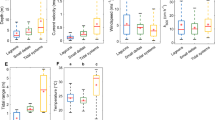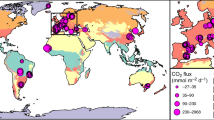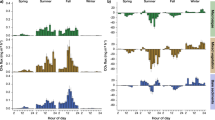Abstract
Coastal ecosystems release or absorb carbon dioxide (CO2), methane (CH4) and nitrous oxide (N2O), but the net effects of these ecosystems on the radiative balance remain unknown. We compiled a dataset of observations from 738 sites from studies published between 1975 and 2020 to quantify CO2, CH4 and N2O fluxes in estuaries and coastal vegetation in ten global regions. We show that the CO2-equivalent (CO2e) uptake by coastal vegetation is decreased by 23–27% due to estuarine CO2e outgassing, resulting in a global median net sink of 391 or 444 TgCO2e yr−1 using the 20- or 100-year global warming potentials, respectively. Globally, total coastal CH4 and N2O emissions decrease the coastal CO2 sink by 9–20%. Southeast Asia, North America and Africa are critical regional hotspots of GHG sinks. Understanding these hotspots can guide our efforts to strengthen coastal CO2 uptake while effectively reducing CH4 and N2O emissions.
This is a preview of subscription content, access via your institution
Access options
Access Nature and 54 other Nature Portfolio journals
Get Nature+, our best-value online-access subscription
$29.99 / 30 days
cancel any time
Subscribe to this journal
Receive 12 print issues and online access
$209.00 per year
only $17.42 per issue
Buy this article
- Purchase on Springer Link
- Instant access to full article PDF
Prices may be subject to local taxes which are calculated during checkout




Similar content being viewed by others
Data availability
All of the data included in this study are freely available at https://doi.org/10.6084/m9.figshare.22351267. These data may be used if cited appropriately.
References
IPCC Climate Change 2021: The Physical Science Basis (eds Masson-Delmotte, V. et al.) (Cambridge Univ. Press, 2021).
Tian, H. et al. The terrestrial biosphere as a net source of greenhouse gases to the atmosphere. Nature 531, 225–228 (2016).
Raymond, P. A. et al. Global carbon dioxide emissions from inland waters. Nature 503, 355–359 (2013).
Zheng, Y. et al. Global methane and nitrous oxide emissions from inland waters and estuaries. Glob. Chang. Biol. 28, 4713–4725 (2022).
Regnier, P., Resplandy, L., Najjar, R. G. & Ciais, P. The land-to-ocean loops of the global carbon cycle. Nature 603, 401–410 (2022).
Abril, G. & Borges, A. V. Ideas and perspectives: carbon leaks from flooded land: do we need to replumb the inland water active pipe? Biogeosciences 16, 769–784 (2019).
Cai, W.-J. Estuarine and coastal ocean carbon paradox: CO2 sinks or sites of terrestrial carbon incineration? Ann. Rev. Mar. Sci. 3, 123–145 (2011).
Bauer, J. E. et al. The changing carbon cycle of the coastal ocean. Nature 504, 61–70 (2013).
Chen, C. T. A. et al. Air–sea exchanges of CO2 in the world’s coastal seas. Biogeosciences 10, 6509–6544 (2013).
Laruelle, G. G. et al. Global multi-scale segmentation of continental and coastal waters from the watersheds to the continental margins. Hydrol. Earth Syst. Sci. 17, 2029–2051 (2013).
Macreadie, P. I. et al. Blue carbon as a natural climate solution. Nat. Rev. Earth Environ. 2, 826–839 (2021).
Gattuso, J.-P., Williamson, P., Duarte, C. M. & Magnan, A. K. The potential for ocean-based climate action: negative emissions technologies and beyond. Front. Clim. 2, 575716 (2021).
Rosentreter, J. A., Maher, D. T., Erler, D. V., Murray, R. H. & Eyre, B. D. Methane emissions partially offset “blue carbon” burial in mangroves. Sci. Adv. 4, eaao4985 (2018).
Oreska, M. P. J. et al. The greenhouse gas offset potential from seagrass restoration. Sci. Rep. 10, 7325 (2020).
Rosentreter, J. A., Al‐Haj, A. N., Fulweiler, R. W. & Williamson, P. Methane and nitrous oxide emissions complicate coastal blue carbon assessments. Glob. Biogeochem. Cycles 35, e2020GB006858 (2021).
Williamson, P. & Gattuso, J. Carbon removal using coastal blue carbon ecosystems is uncertain and unreliable, with questionable climatic cost-effectiveness. Front. Clim. 4, 853666 (2022).
Rosentreter, J. A. et al. Half of global methane emissions come from highly variable aquatic ecosystem sources. Nat. Geosci. 14, 225–230 (2021).
Al‐Haj, A. N. & Fulweiler, R. W. A synthesis of methane emissions from shallow vegetated coastal ecosystems. Glob. Change Biol. 26, 2988–3005 (2020).
Borges, A. V. & Abril, G. in Treatise on Estuarine and Coastal Science Vol. 5 119–161 (Elsevier, 2011).
Maher, D. T., Sippo, J. Z., Tait, D. R., Holloway, C. & Santos, I. R. Pristine mangrove creek waters are a sink of nitrous oxide. Sci. Rep. 6, 25701 (2016).
Murray, R., Erler, D., Rosentreter, J., Maher, D. & Eyre, B. A seasonal source and sink of nitrous oxide in mangroves: insights from concentration, isotope, and isotopomer measurements. Geochim. Cosmochim. Acta 238, 169–192 (2018).
De Wilde, H. P. J. & De Bie, M. J. M. Nitrous oxide in the Schelde estuary: production by nitrification and emission to the atmosphere. Mar. Chem. 69, 203–216 (2000).
Murray, R. H., Erler, D. V. & Eyre, B. D. Nitrous oxide fluxes in estuarine environments: response to global change. Glob. Change Biol. 21, 3219–3245 (2015).
Kroeze, C., Dumont, E. & Seitzinger, S.Future trends in emissions of N2O from rivers and estuaries. J. Integr. Environ. Sci. 7, 71–78 (2010).
Maavara, T. et al. Nitrous oxide emissions from inland waters: are IPCC estimates too high? Glob. Change Biol. 25, 473–488 (2019).
Ciais, P. et al. Definitions and methods to estimate regional land carbon fluxes for the second phase of the REgional Carbon Cycle Assessment and Processes Project (RECCAP-2). Geosci. Model Dev. 15, 1289–1316 (2020).
Bunting, P. et al. The Global Mangrove Watch—a new 2010 global baseline of mangrove extent. Remote Sens. 10, 1669 (2018).
Mcowen, C. et al. A global map of saltmarshes (v6.1). Biodivers. Data J. 5, e11764 (2017).
Short, F. T. Global Distribution of Seagrasses (Version 6.0). Sixth Update to the Data Layer Used in Green and Short (2003). (UN Environment Programme World Conservation Monitoring Centre, 2017); https://data.unep-wcmc.org/datasets/7
Laruelle, G. G., Rosentreter, J. A. & Regnier P. Extrapolation based regionalized re-evaluation of the global estuarine surface area. Preprint at Earth ArXiv https://doi.org/10.31223/X5X664 (2023).
Dürr, H. H. et al. Worldwide typology of nearshore coastal systems: defining the estuarine filter of river inputs to the oceans. Estuaries Coasts 34, 441–458 (2011).
Woodwell, G. M., Rich, P. H. & Hall, C. A. S. in Carbon and the Biosphere (eds Woodwell, G. M. & Pecan, E. V.) 221–240 (Technical Information Center, United States Atomic Energy Commission & National Technical Information Service, 1973).
Stewart, B. T., Santos, I. R., Tait, D. R., Macklin, P. A. & Maher, D. T. Submarine groundwater discharge and associated fluxes of alkalinity and dissolved carbon into Moreton Bay (Australia) estimated via radium isotopes. Mar. Chem. 174, 1–12 (2015).
Borges, A. V. et al. Variability of the gas transfer velocity of CO2 in a macrotidal estuary (the Scheldt). Estuaries 27, 593–603 (2004).
Frankignoulle, M. Carbon dioxide emission from European estuaries. Science 282, 434–436 (1998).
Regnier, P. et al. Modelling estuarine biogeochemical dynamics: from the local to the global scale. Aquat. Geochem. 19, 591–626 (2013).
Lovelock, C. E. & Reef, R. Variable impacts of climate change on blue carbon. One Earth 3, 195–211 (2020).
Alongi, D. M. Carbon cycling and storage in mangrove forests. Ann. Rev. Mar. Sci. 6, 195–219 (2014).
Alongi, D. M. Carbon balance in salt marsh and mangrove ecosystems: a global synthesis. J. Mar. Sci. Eng. 8, 767 (2020).
Bange, H. W., Bartell, U. H., Rapsomanikis, S. & Andreae, M. O. Methane in the Baltic and North Seas and a reassessment of the marine emissions of methane. Glob. Biogeochem. Cycles 8, 465–480 (1994).
Gelesh, L., Marshall, K., Boicourt, W. & Lapham, L. Methane concentrations increase in bottom waters during summertime anoxia in the highly eutrophic estuary, Chesapeake Bay, U.S.A. Limnol. Oceanogr. 61, S253–S266 (2016).
Koné, Y. J. M., Abril, G., Delille, B. & Borges, A. V. Seasonal variability of methane in the rivers and lagoons of Ivory Coast (West Africa). Biogeochemistry 100, 21–37 (2010).
Donato, D. C. et al. Mangroves among the most carbon-rich forests in the tropics. Nat. Geosci. 4, 293–297 (2011).
Maher, D. T., Santos, I. R., Golsby-Smith, L., Gleeson, J. & Eyre, B. D. Groundwater-derived dissolved inorganic and organic carbon exports from a mangrove tidal creek: the missing mangrove carbon sink? Limnol. Oceanogr. 58, 475–488 (2013).
Rao, G. D. & Sarma, V. V. S. S. Variability in concentrations and fluxes of methane in the Indian estuaries. Estuaries Coasts 39, 1639–1650 (2016).
Bange, H. W., Rapsomanikis, S. & Andreae, M. O. The Aegean Sea as a source of atmospheric nitrous oxide and methane. Mar. Chem. 53, 41–49 (1996).
Chmura, G. L., Kellman, L., van Ardenne, L. & Guntenspergen, G. R. Greenhouse gas fluxes from salt marshes exposed to chronic nutrient enrichment. PLoS ONE 11, e0149937 (2016).
Dausse, A. et al. Biogeochemical functioning of grazed estuarine tidal marshes along a salinity gradient. Estuar. Coast. Shelf Sci. 100, 83–92 (2012).
Chen, J., Wells, N. S., Erler, D. V. & Eyre, B. D. Land‐use intensity increases benthic N2O emissions across three sub‐tropical estuaries. J. Geophys. Res. Biogeosciences 127, e2022JG006899 (2022).
Murray, N. J. et al. High-resolution mapping of losses and gains of Earth’s tidal wetlands. Science 376, 744–749 (2022).
Shields, M. R. et al. Carbon storage in the Mississippi River delta enhanced by environmental engineering. Nat. Geosci. 10, 846–851 (2017).
Gillies, S., Ward, B., & Petersen, A. S. Rasterio. GitHub https://github.com/mapbox/rasterio (2013).
Jordahl, K. et al. Geopandas/geopandas: v0.8.1. Zenodo https://doi.org/10.5281/zenodo.3946761 (2020).
Mayorga, E. et al. Global Nutrient Export from WaterSheds 2 (NEWS 2): model development and implementation. Environ. Model. Softw. 25, 837–853 (2010).
Forster, et al. in Climate Change 2021: The Physical Science Basis (eds Masson-Delmotte, V. et al.) 923–1054 (Cambridge Univ. Press, 2021).
R Core Development Team. R: A Language and Environment for Statistical Computing (R Foundation for Statistical Computing, 2020).
Acknowledgements
We thank the RECCAP2 Scientific Committee and members of the Global Carbon Project who initiated this group effort (https://www.globalcarbonproject.org/reccap/index.htm). We thank the following members of the AmeriFlux site teams who contributed annual net ecosystem CO2 exchange sums for their sites: E. Stuart-Haëntjens, B. Bergamaschi, L. Windham-Myers, A. Vázquez-Lule, R. Vargas, J. Shahan, P. Oikawa, P. Hawman, D. Mishra, R. Sanders-DeMott and P. Polsenaere. J.A.R. and T.M. acknowledge funding from the Hutchinson Postdoctoral Fellowship of the Yale Institute for Biospheric Studies at Yale University. I.F. acknowledges the National Science Foundation Long Term Ecological Research program (OCE 1637630). R.G.N. acknowledges support from the National Aeronautics and Space Administration’s Carbon Cycle Science Program. G.G.L. is a research associate of the F.R.S.–FNRS at the Université Libre de Bruxelles. P.R. received financial support from the Belgian Science Policy Office (through the project ReCAP, which is part of the Belgian research program FedTwin), the European Union’s Horizon 2020 research and innovation program ESM2025—Earth System Models for the Future project (grant number 101003536) and the F.R.S.–FRNS PDR project T.0191.23. B.D.E. acknowledges support from Australian Research Council grants DP220100918, LP200200910 and LP190100271. W.-J.C. acknowledges support from the National Oceanic and Atmospheric Administration and National Science Foundation. J.J.M.B. acknowledges the computational resources provided by Princeton Institute for Computational Science and Engineering, which were used for the land segmentation. B.V.D. was supported by the Bundesministerium für Bildung und Forschung project CARBOSTORE (number 03F0875A), as well as the German Academic Exchange Service project ‘The ocean’s alkalinity: connecting geological and metabolic processes and time-scales’ (number 57429828).
Author information
Authors and Affiliations
Contributions
J.A.R. and P.R. conceived of and designed the study. J.A.R. performed the synthesis for CH4 and N2O in estuaries, CH4 and N2O in coastal vegetation and CO2 in mangroves. B.D.E. and H.W.B. helped with the synthesis for N2O in estuaries and coastal vegetation. T.M. provided the mechanistic model for N2O in estuaries. G.G.L. performed the synthesis for CO2 in estuaries and segmented the estuarine surface area. I.F. performed the synthesis for CO2 in salt marshes. B.V.D. performed the synthesis for CO2 in seagrasses. J.J.M.B. segmented the coastal vegetation surface area. J.A.R. produced the results and figures and wrote the original draft of the paper. All authors helped with interpretation of the data and contributed to reviewing and editing the paper.
Corresponding author
Ethics declarations
Competing interests
The authors declare no competing interests.
Peer review
Peer review information
Nature Climate Change thanks Shuwei Li, James Megonigal, Dongqi Wang and Cathleen Wigand for their contribution to the peer review of this work.
Additional information
Publisher’s note Springer Nature remains neutral with regard to jurisdictional claims in published maps and institutional affiliations.
Extended data
Extended Data Fig. 1 Regional and global surface areas of estuaries and coastal vegetation.
Surface areas of estuaries a) as a relative percentage (%) and b) in km2 of tidal systems and deltas, lagoons, and fjords in the ten RECCAP2 regions and globally. Surface areas of coastal vegetation c) as a relative percentage (%) and d) in km2 of mangroves, salt marshes, and seagrasses in the ten RECCAP2 regions and globally. The global surface area for estuaries is 733,801 km230. The global coastal vegetation area is 512,982 km2. Surface areas (km2) for each estuary and coastal vegetation type in each of the ten regions can be found in Supplementary Table S4.
Extended Data Fig. 3 Greenhouse gas study site locations in estuaries and coastal vegetation.
Map showing locations of CO2, CH4, and N2O flux studies in the ten RECCAP2 regions in estuaries (left side): tidal systems and deltas, lagoons, and fjords, and coastal vegetation (right side): mangroves, salt marshes, and seagrasses, from peer-reviewed publications until the end of 2020. The number of study sites can be found in Supplementary Table S8.
Extended Data Fig. 4 Bootstrapping approach.
Bootstrapping was applied to randomly resample flux densities of the three greenhouse gases (level 1) for each estuary or coastal vegetation types (level 2) for each of the ten RECCAP2 regions (level 3) before upscaling to specific surface areas (see Supplementary Table S4).
Supplementary information
Supplementary Information
Supplementary text, PRISMA flow chart and Tables 1–8.
Rights and permissions
Springer Nature or its licensor (e.g. a society or other partner) holds exclusive rights to this article under a publishing agreement with the author(s) or other rightsholder(s); author self-archiving of the accepted manuscript version of this article is solely governed by the terms of such publishing agreement and applicable law.
About this article
Cite this article
Rosentreter, J.A., Laruelle, G.G., Bange, H.W. et al. Coastal vegetation and estuaries are collectively a greenhouse gas sink. Nat. Clim. Chang. 13, 579–587 (2023). https://doi.org/10.1038/s41558-023-01682-9
Received:
Accepted:
Published:
Issue Date:
DOI: https://doi.org/10.1038/s41558-023-01682-9
This article is cited by
-
Anthropogenic impacts on mud and organic carbon cycling
Nature Geoscience (2024)
-
High carbon dioxide emissions from Australian estuaries driven by geomorphology and climate
Nature Communications (2024)
-
Spatio-temporal changes and hydrological forces of wetland landscape pattern in the Yellow River Delta during 1986–2022
Landscape Ecology (2024)
-
Mangroves of Malaysia: a comprehensive review on ecosystem functions, services, restorations, and potential threats of climate change
Hydrobiologia (2024)
-
Wastewater-influenced estuaries are characterized by disproportionately high nitrous oxide emissions but overestimated IPCC emission factor
Communications Earth & Environment (2023)



